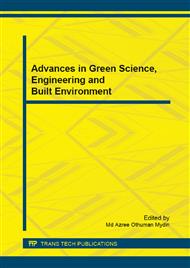p.136
p.141
p.145
p.149
p.153
p.157
p.161
p.165
p.168
Importance of Preserving the Non-Use Value of the Cultural Heritage: Case Study of George Town, Penang World Heritage Site
Abstract:
This paper aims to focus on the attitude and responses of the stakeholders on the importance of preserving the non-use value of cultural heritage for George Town, Penang World Heritage Site (GPWHS) conservation. This research has examined the possibilities of several attitudes of the stakeholders in explaining the importance of preserving the non-use value for the GPWHS conservation. Pearson’s Correlation and Multiple Linear Regressions were used in predicting the dependent variable using a set of several independent variables. The purpose of the correlation test was to prove whether the correlation between the dimensions of the independent variables has had any influence on the non-use value of cultural heritage for the GPWHS conservation. A face-to-face interviewing technique using the structured CV questionnaire aided by photo images-supported was applied in this survey. The numbers of completed questionnaires were 294 from local residents and 147 from tourists (domestic and foreign) in GTWHS. This paper reveals that there was a relationship between the local stakeholders’ attitude and responses on the importance of preserving the non-use value and the WTP value for the GTWHS conservation.
Info:
Periodical:
Pages:
153-156
Citation:
Online since:
March 2015
Authors:
Keywords:
Price:
Сopyright:
© 2015 Trans Tech Publications Ltd. All Rights Reserved
Share:
Citation:


